
Learning and Decision Making in the Canopy
How does life in the canopy shape the evolution of the mind? The foraging decisions of kinkajous - an elusive species that forages in neo-tropical forest canopies at night - may offer some clues. The central aim of this project is to identify the processes of learning and memory that allow kinkajous to keep track of when and where to find their favorite food: fruit. By comparing our findings to what is known about primates, which also live in the canopy and eat fruit, we can gain a better understanding of the general ecological factors that lead to the evolution of greater intelligence. In turn, we may be able to identify how certain habitats facilitate the emergence of complex societies by selecting for brains that are better able to learn about relationships, be they social or spatial.
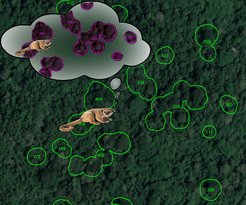
Spatial Learning and the Cognitive Map
To start understanding foraging decisions, we study an essential component of navigation in arboreal mammals: the cognitive map. The cognitive map is an associative network of information in the hippocampus and its associated brain regions. The information contained in a cognitive map might include landmarks and their relationships to important food resources, routes that connect important locations, and information about what foods might be available at a given location. Recent evidence suggests that in some animals, including humans, cognitive maps can do much more. For example, they may keep track of social networks, the temporal order of memories, and the relationships between words in a language. If true, the way an animal thinks about spatial relationships between food resources could reveal a lot about the way it thinks about more abstract relationships in its world.
The prevalence of intelligent behavior across primate species, including the formation of complex societies, suggests ecological features relevant to their common ancestor selected for the elaboration of cognitive maps. The distribution of primates’ primary food source, fruit, is a highly plausible candidate. Fruit abundance is highly concentrated in small regions of space and time; the ability to keep track of when and where it will appear through a cognitive map would help primates find food without spending large amounts of energy searching for it. To test this hypothesis, however, it is not sufficient to only study primates. Studying the cognition of other mammals that live in the canopy, particularly those with similar diets but different social structures, is essential as well. Comparing the movement of these animals that share a habitat can help us answer questions about how this ecological niche shapes the evolution of navigation, learning, and memory.
For example, can all arboreal, fruit eating mammals anticipate when and where trees will produce fruit? And what information do different mammals use to make such predictions?
When do arboreal mammals navigate by following known routes and when do they forge new paths?
How do arboreal mammals find and learn efficient routes in three dimensions?
Do specific mechanisms of memory formation affect these behaviors?
Kinkajou Navigation
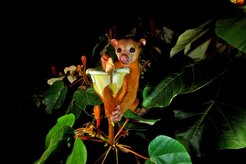
To answer these questions, we examine the interaction of information acquisition and movement in arboreal mammals.
This project focuses on one little-known and little studied mammal: the kinkajou (Potos flavus). Kinkajous look like a cross between a small dog and a monkey, for good reason.
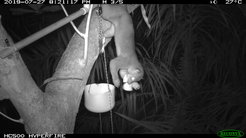
Like dogs, kinkajous belong to the order Carnivora (their closest relatives include racoons and coatis) and have inherited the same long jaw and large canines. But because kinkajous’ diet and environment are so similar to those of primates, they have also evolved some of the features primates are famous for, including prehensile tails and grasping paws. Like primates, kinkajous use these features to climb onto the ends of branches and collect hard to reach fruit – an example of convergent evolution, in which similar traits evolve separately in distantly related animals because of their adaptive value in an ecological niche. While the convergent evolution of kinkajous and primates is apparent physically, it is harder to see whether their minds have evolved convergently as well.
Kinkajous have some key differences from most primates, too. They forage almost exclusively at night, for one. They are also less social than most primates, denning in small groups of one to five and typically foraging alone. By studying kinkajous’ movement, and comparing our findings to existing data from primates and other fruit-eating animals, our research helps to tease apart the roles of diet, canopy structure, perception, and sociality in the evolution of spatial learning and navigation.
Kinkajou Foraging in Natural Systems
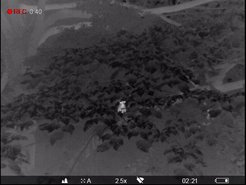
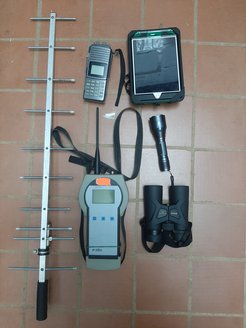
Using aerial drone photography to monitor the blooming and falling of flowers in a large balsa tree and thermal video recordings to track kinkajou movements within the tree crown, we are able to analyze how kinkajous respond to changing flower distributions. These data allow us to look for evidence of flexible decision making and the use of efficient paths between newly discovered flowers.
We also equip kinkajous with high resolution telemetry (movement tracking) collars that collect GPS location and body acceleration in three dimensions. Additionally, these collars emit a trackable radio signal. Using a combination of active tracking to directly observe kinkajous’ behavior and the remotely collected data from the collars, Alexander, the project lead, aims to identify broader patterns of kinkajous’ movement. These include the use of routines to monitor their home range, important decision points and foraging locations, and changes in their ranging patterns.
Navigation Experiments and Simulations for Identifying the Learning Processes Behind Changes in Movement Behavior
Another part of this project involves the development of experimental methods for studying cognitive maps in natural environments. This work requires three parts:
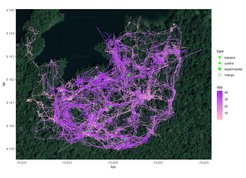
The movement of the kinkajou Molly plotted as a continuous path over satellite imagery of Barro Colorado Island. The color of the path transitions from pink to purple over the nine weeks in which the data were collected. Green shapes indicate locations where different fruits were hoisted into the canopy each night, following an experimental schedule.
1) Developing statistical models of the environmental features that shape an animal’s movement, achieved by analyzing animal telemetry data collected from Barro Colorado Island, Panama by Prof. Dr. Meg Crofoot. 2) Using agent-based models to develop predictions about how different cognitive strategies interact with an animal’s environment to produce identifiable patterns of movement. 3) Designing experimental arrays of food provisioning locations. With careful manipulation of food availability contingencies, we set up experiments to test whether an animal's movement pattern (such as the use of specific routes between resources, or routine visits to particular sequences of locations) change in predictable ways.
By integrating what we learn about how kinkajous forage in their natural environments with the behavior we observe in response to our experimental manipulations, we can test the predictions made by different theoretical models of learning and memory in complex environments. Once we know the model that best explains kinkajou behavior, we can fit this knowledge into the broader context of cognitive evolution. We will then be better equipped to understand the evolution of our own minds, and how that evolution set the stage for the emergence of complex human society.
Further Reading: Cognitive Maps
To learn more about the scientific origins of the cognitive map theory, the best place to start is with the source, Edward Tolman’s seminal paper on cognitive map use in rats. The ambitious reader might look even earlier, to Tolman’s book “Purposive Behavior in Animals and Men", which lays out one of the most influential frameworks for studying learning and decision making in animals. Alternatively, you can explore the development of cognitive map theory through the neuroscientific breakthrough that came with the discovery of place cells in the hippocampus. For a great summary of recent cognitive map research, see this piece by Daniela Schiller and her colleagues. Finally, for some exciting recent work on how bats use cognitive maps to navigate, check out this article from Science.
Kinkajous: Want to learn more about these curious creatures?
Roland Kays has done great work tracking a small population, identifying their social bonds, foraging preferences, and dispersal patterns, click here, and here.
Written by Alexander Vining, Department for the Ecology of Animal Societies
Photos provided by Alexander Vining and Christian Ziegler

















